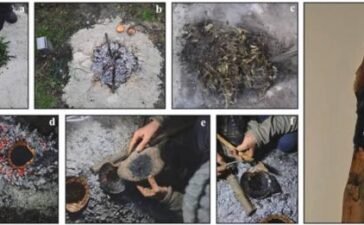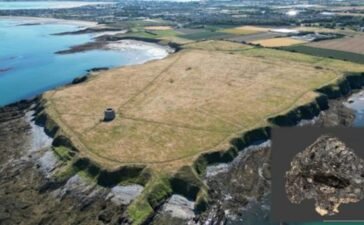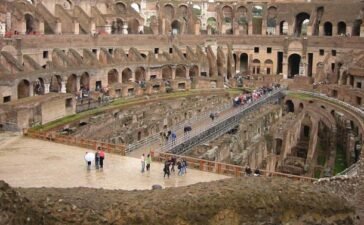Even before the rise of the great Maya civilization, the people who occupied Central America’s Yucatan Peninsula were applying their engineering skills to make the land more productive and liveable. This was made crystal clear by a recent discovery by a team of archaeologists and anthropologists, who discovered the most ancient fish-trapping operation ever identified anywhere in the region inside Belize’s largest inland wetland.
To verify this theory the researchers carried out a series of excavations inside the wildlife sanctuary, and their discoveries confirmed that a series of canals had indeed been dug there a long time ago, to guide and trap freshwater fish in holding ponds where they could be easily harvested.
Notably, the researchers found several barbed spearpoints within the boundaries of the fish-trapping system during their excavations, which presumably would have been tied to sticks to make spears for killing the fish.
The size of the fish-trapping system was quite impressive, the researchers said.
“The network of canals was designed to channel annual flood waters into source ponds for fish trapping and would have yielded enough fish to feed as many as 15,000 people year-round, conservatively,” said University of New Hampshire anthropologist Eleanor Harrison-Buck, in a press release issued by her university.

Researhers excavating sediment that will help them date the evidence of a large-scale pre-Columbian fish-trapping facility. (Belize River East Archaeology (BREA) Project).
Harrison-Buck is the director of the Belize River East Archaeology (BREA) project, and has been leading the ongoing study of ancient fishing practices in Central America. She has been joined by colleagues from the United States and Australia, in a pursuit of knowledge about how ancient humans in the region interacted with wetlands and used them to help meet their survival needs.
A Fish Harvesting Legacy from Deep in Prehistory
At first, the researchers assumed they’d discovered a fish harvesting operation that had been set up by the Maya. But a series of radiocarbon dating tests carried out at various spots inside the canal network proved this wasn’t true.
It seems the fish-trapping network was conceived of and constructed by the people who occupied the land before the rise of the great Maya civilization. These were a semi-nomadic people who settled along the Yucatan Peninsula coastal plain, and who constructed the canal system approximately 4,000 years ago.
“Data collected from the largest inland wetland in Belize, Central America, demonstrate the presence of large-scale pre-Columbian fish-trapping facilities built by Late Archaic hunter-gatherer-fishers, which continued to be used by their Maya descendants during Formative times (approximately 2000 BCE to 200 CE),” the study authors wrote in an article published by Science Advances.
The researchers believe the early practice of fish trapping on such a significant scale was an adaption to changes in environmental conditions in ancient Central America.

Researchers searching for evidence of ancient fishing activity in the Crooked Tree Wildlife Sanctuary in Belize. (Belize River East Archaeology (BREA) Project).
“We suggest that such landscape-scale intensification may have been a response to long-term climate disturbance recorded between 2200 and 1900 BCE,” they wrote. “Agricultural intensification after 2000 BCE has been credited for supporting the rise of pre-Columbian civilizations in Formative Mesoamerica, but we suggest that some groups relied more heavily on the mass harvesting of aquatic resources.”
Sediment samples were collected along the walls of the excavation units, and they were tested for chemical elements that might reveal the types of environment changes that occurred in prehistoric times. These tests showed that tropical forests had dominated the landscapes of the Crooked Tree Wildlife Sanctuary 4,000 years ago, and that no cultivation of maize or any other crops had taken place during that time. Along with a lack of pollen from domesticated crops, there were no signs of the ditching or draining that would have been needed to prepare the land for agricultural use.
As for the fish-trapping network, analysis showed it was used for approximately 1,000 years, or from approximately 2,000 to 1,000 BC.
“It seems likely that the canals allowed for annual fish harvests and social gatherings, which would have encouraged people to return to this area year after year and congregate for longer periods of time,” said study co-author Marieka Brouwer Burg, a professor of anthropology at the University of Vermont and the BREA project co-director. “Such intensive investments in the landscape may have led ultimately to the development of the complex society characteristic of the pre-Columbian Maya civilization, which subsequently occurred in this area by around 1200 BCE.”
Did Their Predecessors Help the Maya Thrive?
The so-called “Formative Period” of the Maya civilization overlapped with the fishing system’s time in use. This suggests the Maya took advantage of this ingenious creation of their predecessors, relying on the harvest of freshwater fish to supplement what they were able to produce their their early ventures into agriculture.
If this is so, the existence of this ancient fishing operation may have been a hidden factor that helps explains the rise of the Maya civilization, which grew to be the most advanced and sophisticated in all of ancient Mesoamerica.
With the support of the local population, the BREA research team plans to return to Crooked Tree to continue their investigations soon. They will be looking for more signs of prehistoric land modification, which could reveal some fascinating facts about how ancient fishing practices led to significant cultural development in the Yucatan region later on.
Top image: Crooked Tree Wildlife Sanctuary in Belize. Source: Bernt Rostad/CC BY 2.0.
By Nathan Falde






